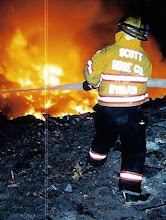Construction
work on this building to hold military service records was completed in
1956. When the original studies were
conducted during the design phase, conflicting advice was received from
archivists and personnel at other government records retention facilities. Some strongly recommended the inclusion of
automatic sprinklers and others argued against.
Not surprisingly, since we are talking about this fire forty years
later, the anti-sprinkler forces won. Storage
of paper records in folders and boxes packed on metal shelves and file cabinets
filled the building—a massive fire load.
The
fire response exceeded 6 alarms. The
interior attack was abandoned at 3:15 AM that morning due to deteriorating
conditions, but the exterior attack continued for days. On the 14th, firefighters
re-entered the building to begin final extinguishment and overhaul on the sixth
floor; a task complicated by partial structural collapse of the roof. By the 16th of July, a single
company remained on scene.
Following
fire extinguishment began a salvage operation which continues even today. Computer tapes and microfilm records were
among the early transfers to an off-site facility. All six floors of the building experienced
substantial water damage, and the recovery of water soaked records was a
massive operation. Wet records were
re-boxed and the escalator railings used as a slide to move them to the ground
floor for transport. Setting up a
temporary facility at the nearby Civilian Personnel Records Center, plastic
milk crates, eventually 30,000 of them, were used for open shelf drying, but a
better solution was on the horizon.
A
vacuum drying chamber was located at the McDonnell Douglas Aircraft plant in
St. Louis. The chamber was originally
constructed for space simulation as part of the Apollo moon program. Once archivists confirmed the technology
worked, two additional chambers at the Sandusky, Ohio NASA facility were located
and used as well. Wet records were
placed in the plastic milk crates, which were stacked nine high on wood
pallets, and the records loaded into the chamber, which was sealed. Air was evacuated from the chamber and the
temperature lowered to freezing. Hot dry
air was then introduced until the wetted materials reach 50 degrees F. Depending upon how wet the material was,
multiple cycles could be needed to dry the records. With a single chamber capable of holding
2,000 milk crates, nearly eight tons or 2000 gallons of water could be removed
during a run.
The
charred and burned materials recoverable from the sixth floor created another
challenge. Luckily, this material was
not disposed of following the fire, but stored as “B” files, as improvements in
technology have made the information from some of these materials usable
again. Today a team of thirty uses the
latest restoration techniques to recover information from these documents. Working
in latex gloves, this group represents an archival CSI for documents; cleaning
mold and debris and utilizing digital technology, scanners, and specialized
software, some information from burned sections can be revealed and
recovered.
Sprinkler protection
became an important component for all such government facilities following this
fire; a lesson learned like many others, through disaster. While we will likely never know how many
records were lost in the fire, the cause of which remains undetermined, that
recovery and restoration continues forty years later is nothing short of
miraculous.
This
information remains important. Requests
are received from veteran’s families for information needed to obtain various
programmatic government benefits along with on-going work by genealogists and
historians. The meticulous work the
recovery team does, like archaeologists unearthing an ancient village filled
with information, is critical in helping these servicemen.






No comments:
Post a Comment